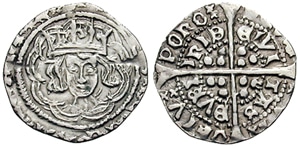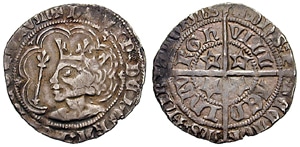The Groat is an interesting coin that was first minted under Kind Edward I.
Learn all about the coin and its history in this guide today.
What is a Groat Coin Worth Today?
If you can find one that has not been turned into pieces of jewelry, expect to pay a minimum of about £0.99 with an average selling price on eBay of between about £24 and £63.
Since the value of the Groat changes drastically depending on which version you are looking for and what condition it is in, some have even sold for between £400 and as much as more than £1,000.

Specifications
This pre-decimal fourpence 4d coin is sometimes called a groat, a fourpenny bit, or a Joey. It was originally worth one-sixtieth of a pound sterling, or fourpence. The face value of a Groat is two Half Groats, 4 pence, or 16 Farthings.
It weighs approximately 3.75g and is commonly used with variations in England, Scotland, and Ireland. Groats were never quite as pure as their official specifications intended due to their rate of production and difficulty keeping them consistent centuries ago.
The groats that were minted under Edward I are very rare. They were issued experimentally. If you come across one today, it will most likely be damaged since they were often used to make jewellery pieces.
There were English, Irish, and Scottish Groats. All were originally worth fourpence. However, later issues of the Scottish coin were valued at eightpence and one shilling.
Today, a Groat’s value varies widely. One very rare 1839 Proof Groat sold on eBay recently for £1,075. More realistically, others have sold for as little as £0.99. Some rare Groat coins in excellent condition have gone as high as £175, with some even selling for as high as around £500. It all depends on which issue and what condition the coin is in as well as matching the right buyer with the seller.
Brief History of the Groat
The word “Groat” comes from the old French word, gros, which means large or great and is named after the French coin called the Gros Turnois. In about 1280, Edward I introduced the Groat as the largest silver coin in circulation in England.
It was worth four pence and remained the largest silver coin for 220 years until Henry VII introduced the testoon, shilling, at the beginning of the 16th century.
When Did the Groat Coin Go Out of Circulation?
Milled currency Groats were not minted until 1836 and were not minted with any regularity. They stopped being minted in the UK in 1856. But, they weren’t quite done yet. In 1888 a special request for a colonial variety was met.
The groat was issued as a circulating coin starting with the reign of Edward III moving forward through the Middle Ages. It continued to be minted until 1856 except for between 1603-1625, during James I reign, and 1649-1660, during the Commonwealth period.
The last groat struck for circulation in Britain was issued in 1855. By this point, it was no longer a large coin as it had gradually shrunk due to inflation. From 1855 onward, the groat has only been issued as part of the Maundy Set that was issued every year by the Monarch on Maundy Thursday but never intended for circulation. There were only a few exceptions to this rule. One exception was two proof issues from 1857 and 1862. Another is an 1888 colonial issue. The Groat was current in the United Kingdom and most colonies until 1887.
The Groat was also minted for use in British Guiana and the British West Indies which remained in circulation in British Guiana until 1955.
How Many Groats are in a Shilling?
Before 1971 decimalization, 240 pence were in one pound sterling. Twelve pence made a shilling. Twenty shillings made a pound.
A shilling or a “Bob”, is worth 12 pence, or 3 Groats, fourpence coins. Shillings were originally referred to as Testoons and were first produced during the reign of King Henry VII, from 1485 to 1509. The name changed to Shilling in the 1600s.
The first English groat, fourpence, was introduced under King Edward I. Before this time, only a penny or halfpenny, cut penny, was in circulation. Groats became a familiar English coin throughout the hammered coinage period and were phased out in 1561 only to reappear about a century later before the end of the hammered coinage period ending in 1662.
The Groat would once again be introduced for a short time during the reigns of William IV and Queen Victoria.
The Henry VII Groats are quite rare and feature Henry VII on the Obverse.
Additional Groats include an image of the monarch on one side and a sectioned off cross on the other with various words and symbols as well as special Maundy Thursday versions:
- Edward II 1327-1377
- Richard II 1377-1399
- Henry IV 1399-1413
- Henry VI 1422-1461, 1470-1471
- Edward IV 1461-1470, 1471-1483
- Richard III 1483-1485
- Henry VII 1485-1509
- Henry VIII 1509-1547
- Edward VI 1547-1553
- Mary I Philip and Mary 1553-1558
- Elizabeth I 1558-1603
- Charles I 1625-1649 Instead of the cross on the reverse side, there are words INIMICI * EXVRGAT * DEVS * DISSIPETITVR and REL: PRO: LEG: ANG: LIB: PAR
- Charles II 1660-1685 The cross is pictured intertwined as two crosses become one
- James II 1685-1688 Instead of the traditional cross, there are Roman numbers II*II that are crowned.
- William and Mary 1688-1694 Instead of the cross on the reverse side, there is a crowned Number 4 and words encircling it.
- Queen Anne 1702-1714 The reverse featured the crowned Number 4
- George II 1727-1760 The reverse continues to feature the Number 4 crowned.
- George III 1760-1820 The Number 4 is crowned on the reverse encircled by the words IVI A G * BRI* PR* ET * HIG * R E X *
- George IV 1820-1830 The reverse features the date split by the Number 4 crowned and leaves encircling the image.
- William IV 1830-1837 The reverse features Britannia.
- Victoria 1837-1901
- Edward VII 1901-1910
- George V 1910-1936
- George VI 1936-1952
- Elizabeth II Starting in 1952
Coin Design
The latest version of the Groat is made of Sterling Silver 0.925 silver equal to 0.0561 oz. ASW.
The Obverse features an Effigy of the ruling British monarch with a legend in Latin reading VICTORIA D:G: BRITANNIAR: REGINA F:D:
The Reverse side features a figure of Britannia, the female personification of Great Britain. She is seated facing right, draped and wearing a helmet. In her left hand is a trident, and an oval shield bearing the crosses of the Union flag is resting in her right hand. Around the rim is a beaded border. To the left and right of the image are the words FOUR PENCE. Underneath the image is the date.

The edge is milled with no inscription.
Variations of the Groat include the following Fourpence coins made from 0.925 silver:
- 1836 with 0.925 silver and a mintage of 4,253,040 featuring William IV on Obverse
- 1837 made of 0.925 silver and featuring William IV with a mintage of 962,280
- 1837 featuring Victoria as a proof only. It was made of 0.925 silver and an unknown mintage
- 1838 with a mintage of 2,150,280 made of 0.925 silver
- 1839 with a mintage of 1,461,240 made of 0.925 silver
- 1840 made of 0.925 silver and a mintage of 1,496,880
- 1841 made of 0.925 silver and a mintage of 344,520
- 1842 made of 0.925 silver and a mintage of 724,680
- 1843 made of 0.925 silver and a mintage of 1,817,640
- 1844 with a mintage of 855,360
- 1845 with a mintage of 914,760
- 1846 with a mintage of 1,366,200
- 1847, mintage 226,200
- 1848, mintage 712,800
- 1849, mintage 380,160
- 1851, mintage 31,300
- 1852, mintage unknown
- 1853, mintage 11,880
- 1854, mintage 1,096,613
- 1855, mintage 646,041
- 1857 Proof only, mintage unknown
- 1858, mintage unknown
- 1862 Proof only, mintage unknown
- 1888, mintage 120,000
Was a Groat a Lot of Money?
Even though the name of the coin suggests it is grand or large, a groat was traditionally worth one-sixtieth of a pound sterling or fourpence.
What Is A Groat Worth Today?
Today, if you find a groat to buy or sell, it could be worth a lot of money. Some extremely rare coins, like one 1836 FDC which is very rare, were listed for a whopping £1,100.00.
While others have sold for quite a bit more than the fourpence face value, this price is the exception rather than the rule. More realistically, expect to find some Groats closer to between £24 and £63 or more for rare coins in excellent condition and as little as £0.99 for others.